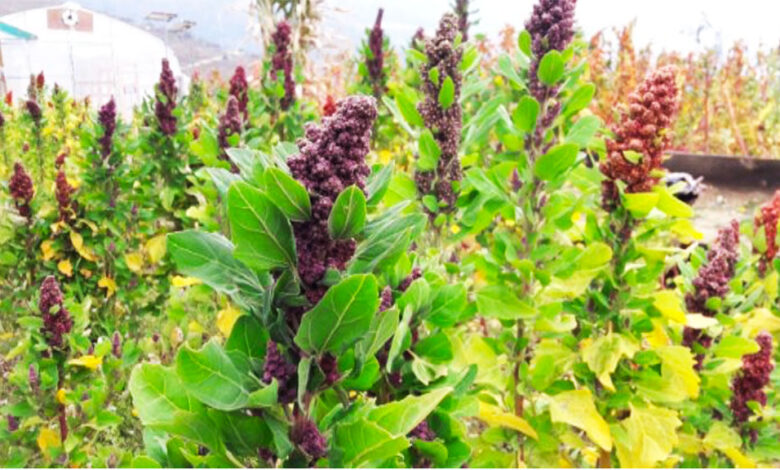Strengthening quinoa initiative for food security and sustainable agri-system

YK Poudel
Quinoa farming in Bhutan has been facing production, post-production, marketing and consumption challenges, demanding urgent attention.
A long-run strategy through stakeholder engagement, geographical indication process, technology and end-product management is underway.
The Food and Agriculture Organisation of the UN (FAO) as the technical lead is carrying out the One Country One Priority Product (OCOP) initiative along with government agencies.
On April 3, representatives from FAO Bhutan, along with other stakeholders from 11 project countries convened a virtual gathering to launch a new project aimed at expanding the OCOP initiative.
National Agrifood and Investment Specialist of FAO Bhutan, Jigme Tenzin, said that the OCOP initiative is linked to a Hand-in-Hand investment forum with FAO as its technical lead.
“Under the Regional OCOP Technical Co-operation Project that supports three countries, Bhutan is focussing on marketing aspects,” Jigme Tenzin said.
The focus, he said, was on four major areas: stakeholder engagement through capacity building and technical processing. Geographical Indication (GI) will work on legislative framework development and Geographical Indication Environmental Sustainability (GIES) which will promote the unique value of the product considering environmental aspects.
“The GIES is an advanced marketing strategy that connects with the high-end market value,” he said.
End-product management, catering to the need for better recipe preparation, he added, is also under process to develop recipes blended into Bhutanese and Western cuisine. “Nutrient profiling and analysis study shall also be done for alternative feasibility.”
In Bhutan, Quinoa has been selected as the priority crop under the OCOP initiative to enhance food and nutritional security, to diversify the cropping and food basket.
Quinoa is a climate-resilient and versatile crop for diverse agroecology as well as a potential export crop for farmers.
Bhutan has also established Quinoa as one of the key National Commodity Programmes to harness its multi-dimensional benefits.
Quinoa was introduced by the erstwhile Ministry of Agriculture and Forests in 2015 with the support of FAO Bhutan to reduce the country’s nutritional gaps.
Dorji Rinchen, deputy chief economic development and marketing officer of the Department of Agriculture Marketing and Cooperatives (DAMC), said that the reasons for the decrease in the price of quinoa within a few years of its introduction were likely due to limited consumer awareness and demand.
“Despite efforts from the department to promote quinoa as a nutritious and versatile grain, widespread acceptance in Bhutanese households is taking time,” Dorji Rinchen said.
Without strong consumer demand, Dorji Rinchen said that prices were likely to decrease as suppliers compete for a limited market share. Competition from other grains, such as traditional staple rice and other Druna Gu cereals, further contributes to the pressure on quinoa prices, as consumers prefer these familiar grains over quinoa.
According to Dorji Rinchen, the department is leveraging various platforms to raise awareness about quinoa, including publications in the inflight magazine of Druk Air and Happiness Journal targeting foreigners visiting Bhutan.
“The department is collaborating with the De-Suung Skilling Program (DSP) to develop diverse quinoa recipes tailored to Bhutanese taste and preferences,” Dorji Rinchen said.
Short videos and booklets on the nutritional benefits of quinoa are also being produced.
Issues
Challenges such as limited consumer awareness, declining production, and fluctuating prices have affected quinoa’s popularity.
Production challenges encompass factors like limited access to high-yielding varieties, inadequate crop management practices, insufficient availability of fertilisers, and outdated farming technologies. Post-production and value-addition hurdles include constrained post-harvest handling, processing facilities, and limited integration of Information and Communication Technology (ICT) in the country. Marketing challenges revolve around a knowledge gap, restricted market access, insufficient policy support, and the absence of modern marketing technologies. Consumption challenges encompass such as food recipes, promotion policies, and awareness efforts, among others.
Records with the agriculture ministry show that, over the years, both the number of quinoa growers and the area under cultivation have been decreasing.
Data for 2022 shows 331 quinoa growers, with approximately 36 acres of land used across 18 dzongkhags resulting in an annual production of about 18 metric tonnes of quinoa.
The State of Food Security and Nutrition in the World 2023 outlines a non-significant decrease in food insecurity in Asia, with 24.2 percent of the population facing moderate or severe food insecurity in 2022 compared with 24.5 percent in 2021.
Efforts
The OCOP initiative, a flagship programme of FAO, is designed to support member countries in transitioning to more efficient, inclusive, resilient, and sustainable agrifood systems through strengthened value chains of Special Agricultural Products (SAPs).
By promoting sustainable production, storage, processing, and marketing of selected SAPs, OCOP contributes to the development of smallholders and family farms, aligning with FAO’s Strategic Framework 2022-31 and the United Nations Sustainable Development Goals (SDGs).
Funded by the FAO Flexible Voluntary Contribution (FVC), the global project will end next year with a funding of USD 500,000.
Dorji Rinchen said that efforts and plans were underway to address these challenges and unlock the full potential of quinoa production in Bhutan.
“Quinoa’s potential to support food security in Bhutan extends beyond its nutritional value. As a climate-resilient crop, it offers a viable alternative to traditional staples and enhances the resilience of the agricultural sector to climate change,” he said.
Local quinoa recipe contests, aimed at encouraging farmers, are also being planned.
The department is looking at enhancing the export market in Singapore, Bangladesh, and India.
Future
In the 13th Five-Year Plan, the government strategised to enhance marketing opportunities for quinoa, primarily focusing on integrating quinoa into the School Feeding Programme.
“Currently, schools across the country consume an average of 6,921 metric tonnes of rice annually, amounting to Nu 291 million,” Dorji Rinched said. “To promote local quinoa production and create a more sustainable market, the department is proposing to replace five percent of this rice consumption with quinoa.”
A project initiated by the Ministry of Agriculture and Livestock titled “Scaling the Implementation of OCOP Initiative” aims to bolster value-chain-based markets to elevate income levels, promote gender-responsive rural livelihoods, and generate employment opportunities. This endeavour is backed by a funding of USD 1 million in the region.
The Country Programming Framework for Bhutan has listed four priority interventions: evidence-based policy and planning, value chain and market-oriented agri-sector, carbon-neutral, and disaster-resilient RNR farming sector in Bhutan.
Strategies for Quinoa Production, Research and Development in Bhutan 2022 aims to identify factors that strengthen the production, research and development of quinoa for local and export markets and to provide suggestions for possible interventions at different levels from production to marketing, including policy related to quinoa.
Jigme Tenzin said that in the 13th Five-year Plan, relevant agencies would work towards the expansion of 4,000 acres of land for quinoa farming.
“Annual production target of 2,360 MT involving 4,000 households will be facilitated,” he said. “The Food Corporation of Bhutan Limited processes four MT of quinoa per day, which will be increased to eight MT daily.”
Renewable Natural Resources Strategy 2040 focuses on bringing an output ensuring food and a healthy environment, achieving food self-reliance, competitive agriculture value-chain and enhancing socio-economic wellbeing.
Since the launch of the OCOP in September 2021, over 85 members from all five FAO regions have expressed strong preliminary interest in promoting the green development of over 55 Special Agricultural commodities.


